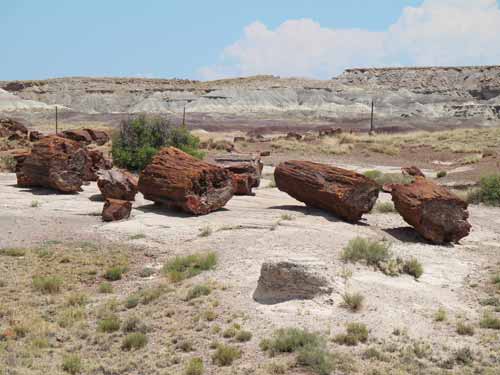



Apparently there are different levels of petrification. The first type is called permineralization. This is where silica crystals (quartz) grew inside the cell walls, eventually filling and replacing the central cavity of the cells. But then, perhaps due to a lack of water, it stopped, leaving the organic cell walls intact but embedded with silica. This type of petrified log is tan and brown and tends to resemble modern wood... although it is stone.
If the petrification process continued, then all remaining organic material was replaced by the silica crystals. This creates a complete copy of the wood and is known as agatized wood.


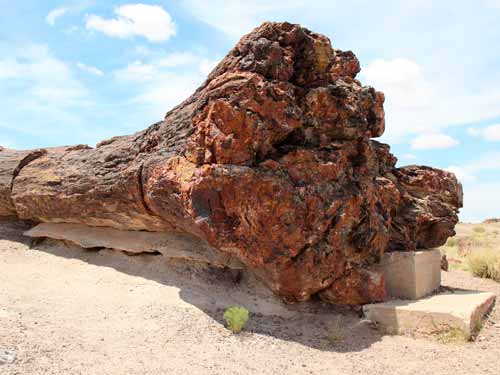
Old Faithful is a 35-foot long section of log, estimated to weigh around 44 tons. It is almost 10 feet across the base. The roots and branches broke off either during the log's journey downstream or after fossilization and exposure. Since petrified logs are composed of quartz, they are hard and brittle and break easily when subjected to stress (which is why the logs are in so many chunks). In July 1962, lightning stuck the rock log and fractured it even more. At the time, the National Park Service added the cement base to try to save it.
We went back into the museum to join a ranger tour at 11 am. Lauren talked about geology, fossils, and the Triassic... the Age of Reptiles and Dawn of the Dinosaurs!

The Chinle Formation covers a range of 18 million years. The rocks give clues to the environment. Sandstone implies there was water, and the colors tell which minerals were present. Iron oxides (reds and yellows) implies the land was exposed to oxygen, hence there was less water. Blues and purples indicate the land was under or around more water. We can also tell the speeds of deposits as well as possible mini-extinctions (meteors) and small regional ones (mud slides, flooding).
The rocks contain many other traces of the past as well, not just petrified wood. There are numerous impressions from ferns and leaves, fossilized freshwater shells, and of course large reptiles and amphibians. There were dinosaurs about but they were still very small.
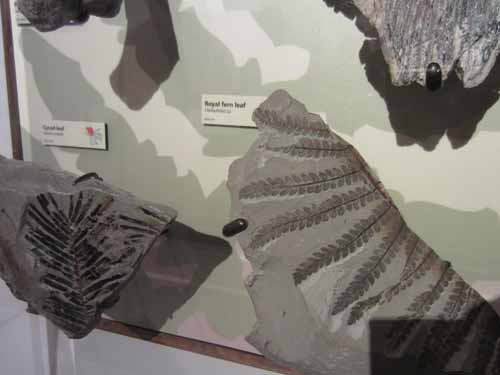
Ferns

Tracks

Rauisuchians were more closely related to crocodiles than dinosaurs.

Our wizard friend... Placerias hesternus was a large reptile that possessed many mammalian characteristics. This plant-eater got up to 9 feet long and weighed as much as two tons.

Metopasaur was a 6-foot long salamander. It would hunt via water vibrations since the water was far too murky to see through.

Passing around various fossils such as this tooth

These murals show life 223 million years ago, during the Blue Mesa rock formation age, back before this area moved 2,100 miles northwest.


Mr. Wizard


A polished piece
Here in the national park, we only see the fossilized trees on the surface that have been exposed by erosion. It is possible they go down 30 to 100 feet deep. Private lands have dug down to find wood to sell but the park hasn't.
Another interesting thing we learned about the different levels of petrification was the 'sound' the rocks made when knocked together. The partially petrified pieces mad a lighter, 'clinky' sound, while the fully rock pieces made a solid 'klunky' sound.
On the way out of the park, we stopped at the touristy Petrified Forest Gift Shop.

Um... I think there is an extra unintended dot.

Petrified wood was everywhere!

Again, touristy dinosaurs were abundant as well.


Ha ha! He has the same look on his face that I think I would!

Oodles of geodes (front and center) and petrified wood

A piece I bought

The top half of the Arizona flag symbolizes their picturesque sunsets, with red and yellow also being the colors of the flag of Spain. The stripes are for the 13 original states; the star is for their copper mining industry, and blue represents liberty.

A flag honoring the Indian nations, with the wolf, eagle and bison
We then stopped at Jim Gray's Petrified Wood Co., an absolutely giant emporium of all sorts of fossilized things. There was even an ample museum inside. I bought two more pieces of wood.


Piles and piles of petrified wood, sold by weight
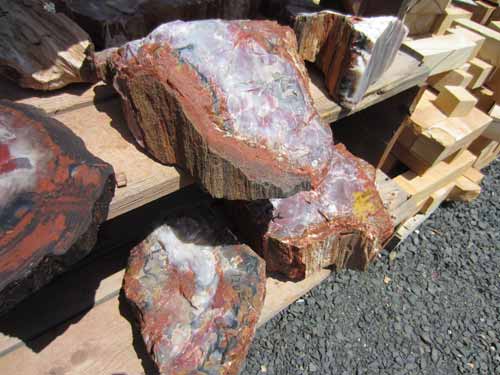
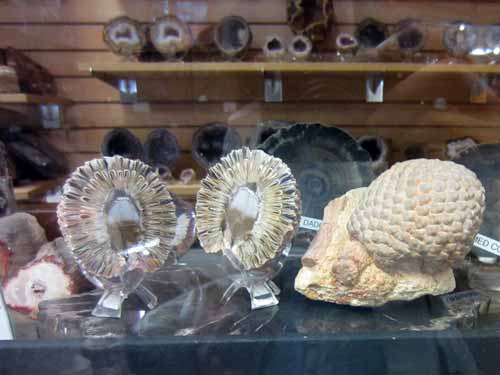
Some of the items in the museum


Green petrified wood, due to chromium, is extremely rare.

Wild Bill is a fossilized alligator from Florida, around 2.9 million years old.

A big piece of coprolite... also known as a big pile of petrified dinosaur crap!
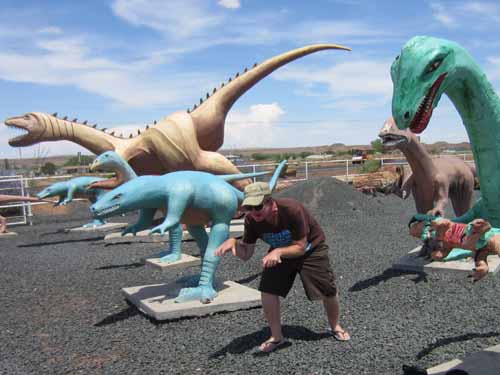
Standing in the middle of all these things gave a rather creepy feeling...

... They were so solid and big that one could easily imagine they were real!
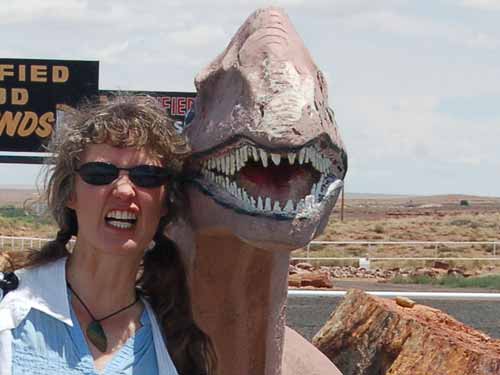
Nope... pathetic. I wouldn't stand a chance!
We swung through Holbrook, tanked up (both the car and ourselves), then hit the road.

An old-fashioned gas pump... the nozzle hose attaches to the side and there is no way to pay at the pump.

Also, look at the increments of the top number.

Our fuel... an ultra-sweet A&W rootbeer float. Our choices were hard or soft ice-cream. The guy in front of us at the counter got one with soft ice-cream. He was still standing there when we stepped up and asked the woman which was better. She loudly said soft ice-cream was not NEARLY as good as hard ice-cream. He glanced at her out of the corner of his eye then slunk away.
Our next stop was the Hubbell Trading Post. To get there, we had to take the 191 North. But the exit was closed. So we drove six miles to the next stop with the intention of turning around and catching the 191N exit from the other direction... but it too was closed. So we had to go another mile to the following exit. We crossed over the highway then headed back. We followed detour sign which took us off at the next exit. OH! But this is only for the 191 South! We asked a construction worker how the heck are we supposed to get to the 191N. She said the next exit down the freeway... except that because of the construction on this exit, we couldn't continue along the way were were going. Instead, we had to go back up the other direction, turn around where we turned around the first time, then head back down the freeway, past this exit to the next one. Sigh.

Growling thunderstorms surrounded us with miles and miles of black clouds. Thick bolts of lightning streaked to the ground. And yet we didn't see a single drop of rain.



